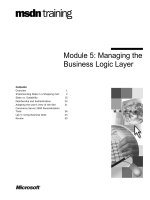Tài liệu Data Centers Lowering the Cost of Ownership pptx
Bạn đang xem bản rút gọn của tài liệu. Xem và tải ngay bản đầy đủ của tài liệu tại đây (686.99 KB, 4 trang )
CASE STUDY
Data Centers
Lowering the Cost of Ownership
CHALLENGE
A wireless service provider sought to minimize both capital and
operating expenses by redesigning its data centers. Major network
elements chosen for the data centers included Cisco 7500 routers,
Cisco Catalyst 6509 Ethernet switches and other data servers—each
with unique connection requirements. After initial installation, it was
highly likely that servers would be added and changed while at some
point in the near-future, software would require upgrades. Experience
taught network planners that new routers, switches and servers
alone presented only part of a sound design for data centers on the
10/100Base-T and Gigabit Ethernet network.
Network planners knew from experience that an infrastructure
without proper connectivity and cable management would defeat
the goal of creating highly efficient, reliable and cost-effective data
centers. Specifically, network planners, following an across-the-
company mandate to reduce operating costs and make smarter use
of capital, determined that each data center must have the following
characteristics:
• Quick addition, upgrade, or rearrangement of any Ethernet switch
or data server with minimal service disruption
• Better use of floor space, and
• Highest quality and reliability of services
CASE STUDY
SOLUTION—ETHERNET DISTRIBUTION FRAME
Network planners met these challenges by incorporating a central patching location called an Ethernet
Distribution Frame (EDF). By creating a centralized, familiar craft interface between Ethernet switching
bays and data servers, network planners ensured that adding servers, upgrading switches and making
other changes in the data center could be done quickly and with minimal service disruptions. The EDF
provides a logical and easy-to-manage infrastructure through two design characteristics:
• All network elements have permanent equipment cable connections that are, once terminated,
never handled again.
• All changes, circuit rerouting, upgrades, maintenance and other activities are accomplished using
semi-permanent patch cords on the front of the EDF cross-connect bay.
10/100/1000
ETHERNET
5800 SERIES
10/100/1000
ETHERNET
5800 SERIES
10/100/1000
ETHERNET
5800 SERIES
10/100/1000
ETHERNET
5800 SERIES
10/100/1000
ETHERNET
5800 SERIES
10/100/1000
ETHERNET
5800 SERIES
10/100/1000
ETHERNET
5800 SERIES
10/100/1000
ETHERNET
5800 SERIES
10/100/1000
ETHERNET
5800 SERIES
10/100/1000
ETHERNET
5800 SERIES
10/100/1000
ETHERNET
5800 SERIES
10/100/1000
ETHERNET
5800 SERIES
10/100/1000
ETHERNET
5800 SERIES
10/100/1000
ETHERNET
5800 SERIES
10/100/1000
ETHERNET
5800 SERIES
10/100/1000
ETHERNET
5800 SERIES
10/100/1000
ETHERNET
5800 SERIES
10/100/1000
ETHERNET
5800 SERIES
10/100/1000
ETHERNET
5800 SERIES
10/100/1000
ETHERNET
5800 SERIES
10/100/1000
ETHERNET
5800 SERIES
10/100/1000
ETHERNET
5800 SERIES
10/100/1000
ETHERNET
5800 SERIES
Ethernet
Distribution
Frame
(EDF)
Ethernet
Switch
Rack
Server
Rack/
Cabinet
25-pair cables
UTP
Patch
Cords
6" Cable
Mgmt
12" Cable
Mgmt
6" Cable
Mgmt
6" Cable
Mgmt
6" Cable
Mgmt
The centralized EDF cross-connect consists of 5800 Series panels with RJ45 front connectors and 25-pair
RJ21x rear connectors. Server racks are equipped with one or more 5800 Series panels that integrate data servers into the
network with permanent, factory tested, pre-terminated RJ21x cable assemblies. Switches in the Ethernet switch rack are
integrated into the network through permanent connections on RJ45 coupler panels using standard RJ45 patch cords.
CASE STUDY
MANAGING CAPITAL THROUGH
SPACE SAVINGS
At the heart of the EDF is ADC’s Glide
Cable Management system. These cable
management troughs bolt onto the side
of standard frames and provide integrated
front, rear, horizontal and vertical cable
management. This eliminates horizontal
cable managers, frees valuable rack space,
and effectively doubles rack density. EDFs
equipped with competitive cable management
systems could only manage up to 456 Ethernet
terminations for this application. However,
network planners could accommodate up
to 912 Ethernet terminations on EDFs using
ADC’s Glide Cable Management system—
saving valuable floor space and reducing or
delaying new construction.
ADC introduced further space savings for data
centers by incorporating its RJ45 to RJ45 Feed
Through Panels into the design. Ordinarily,
connecting an Ethernet switch to the network
requires two separate patch panels to create
a cross-connect patching field to reduce
wear and tear on expensive switch ports by
eliminating direct connections to the switch.
The ADC solution for the service provider’s
Ethernet switch racks saves space by enabling
switch connections using a common RJ45
patch cord with just one patch panel because
each panel has RJ45 connectors on the front
and rear of the panel. Added benefits included
the ability to quickly connect Ethernet switches
to the network, improved designation labeling
on each panel and more secure connections
for Ethernet switching equipment.
REDUCING OPERATING EXPENSES FOR THE LONG TERM
To reduce installation time and errors, the EDF includes 5800 Series patch panels for handling
permanent Ethernet cable connections and creating the patch field for managing moves, adds and
changes. Each 5800 panel features RJ45 connectors on the front and 25-pair RJ21x connectors on the
rear. Experience showed that RJ21x rear terminations shaved cable installation time to about 2 minutes
for each 24-port panel—compared to nearly one hour for each 24-port panel with 110 punch-down
terminations. As the Ethernet service offering grows, installation savings would be significant.
In addition, RJ21x connectors reduced installation errors common with 110 punch-down terminations
such as crossed wires and pairs untwisted too far that often disables valuable ports on Ethernet
equipment. Use of pre-terminated, 100% factory tested RJ21x Category 5e cable assemblies to
connect 5800 distribution panels in active Ethernet bays with 5800 panels in the EDF ensured high
quality terminations and less rework in the CO.
CASE STUDY
ENSURING YEARS OF RELIABILITY
Using a cross-connect with proper cable management
is, in itself, a standard practice for the service provider.
Migrating this practice across all data centers would be
a natural evolution for the operations staff. The ability
to make additions and changes without handling
active equipment cables not only saves technician
time but also protects equipment cables and sensitive
ports on active equipment. The Glide Cable system
actually enforces logical routing of both jumpers and
equipment cables so that the frame remains organized and easy-to-manage even after many changes
have occurred. Built-in bend radius protection and generous cable storage ensure that the high-density
EDF frame allows easy access for moves, adds and changes without service disruptions.
Protecting fiber cables was also an important consideration. ADC showed the service provider how
to create a fiber termination and storage system using the FL2000 fiber management system. The
FL2000 system provides a central place for aggregation and management of fiber cables from Cisco
Catalyst 6509 switches for connection to Cisco 7500 routers in the data center. The solution included
24-port fiber termination panels with SC connectors on angled retainers and integrated slack storage
for full protection of fiber cables. In addition, the solution included inner bay management panels,
spools, and lower trough areas for proper storage of excess cable and patch cord lengths.
Across the EDF, the details of cable management make all the difference in extending service life of
cables and Ethernet ports while creating higher quality service for customers.
CONCLUSION
Spending just 1% to 2% additional capital to implement a cable management and connectivity
system for Ethernet distribution and server management in data centers is a small investment that
yields big returns—decreases in both capital and operating expenses. The EDF eliminates handling
of active equipment cables on Ethernet switches and servers, reducing downtime and speeding
installation and troubleshooting. By implementing a centralized patching infrastructure for data
centers, the service provider is able to manage each data center at a lower cost while maintaining a
high level of service integrity.
Ethernet Distribution Frame
• Glide Cable Management with Slack Management Spools – ADCCMS-12
• 5800 Series Patch Panels – ADCPP245800BTEL
• RJ45 to RJ45 Feed Through Panels – ADCPP24505
• FL2000 System – FL2-RB70024A0-0A00, FL2-HZSTORE-B, FL2-INIMP-22RU-B, FL2-ACC011-B
• PowerWorx Power Distribution Products – PWX-001RGCSD10PSDB
Web Site: www.adc.com
From North America, Call Toll Free: 1-800-366-3891 • Outside of North America: +1-952-938-8080
Fax: +1-952-917-3237 • For a listing of ADC’s global sales office locations, please refer to our web site.
ADC Telecommunications, Inc., P.O. Box 1101, Minneapolis, Minnesota USA 55440-1101
Specifications published here are current as of the date of publication of this document. Because we are continuously
improving our products, ADC reserves the right to change specifications without prior notice. At any time, you may
verify product specifications by contacting our headquarters office in Minneapolis. ADC Telecommunications, Inc.
views its patent portfolio as an important corporate asset and vigorously enforces its patents. Products orfeatures
contained herein may be covered by one or more U.S. or foreign patents. An Equal Opportunity Employer
103271AE 8/06 Revision © 2003, 2004, 2006 ADC Telecommunications, Inc. All Rights Reserved









